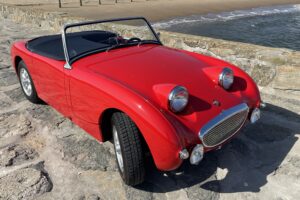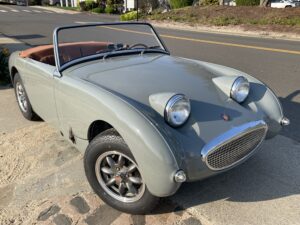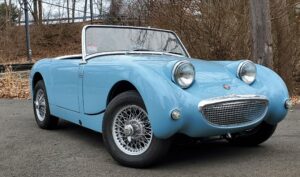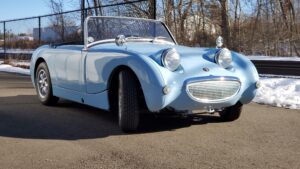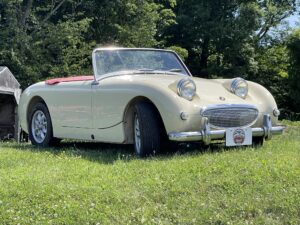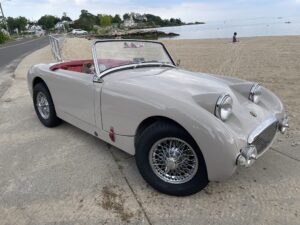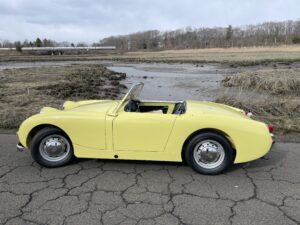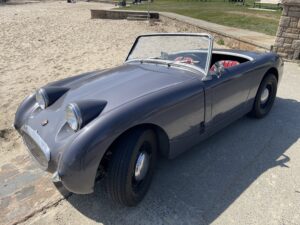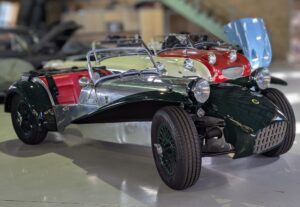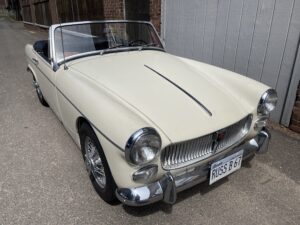
Florida Bugeyeguy Pat Kelly sent us this great Christmas image from his home, and it’s perfect. Thank you Pat! And we all wish you a wonderful holiday season!
by bugeyeguy

Florida Bugeyeguy Pat Kelly sent us this great Christmas image from his home, and it’s perfect. Thank you Pat! And we all wish you a wonderful holiday season!
by bugeyeguy
If you are looking for a great little sportscar, this 1969 AH Sprite may be just the ticket. The 1969 Sprite on the left below is now available for a new owner (the 1966 Sprite on the right has just departed for California).
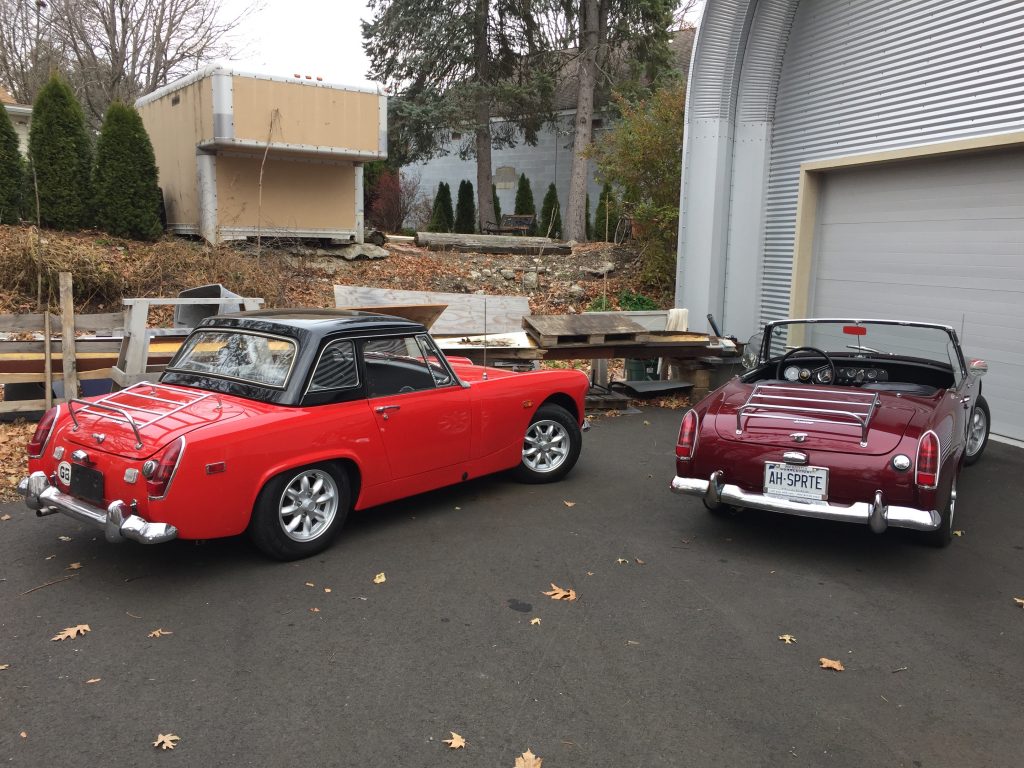
This 69 Sprite is a really nice driver that was completely stripped and rebuilt in 1988-1989. She has been driven regularly since and still looks great!
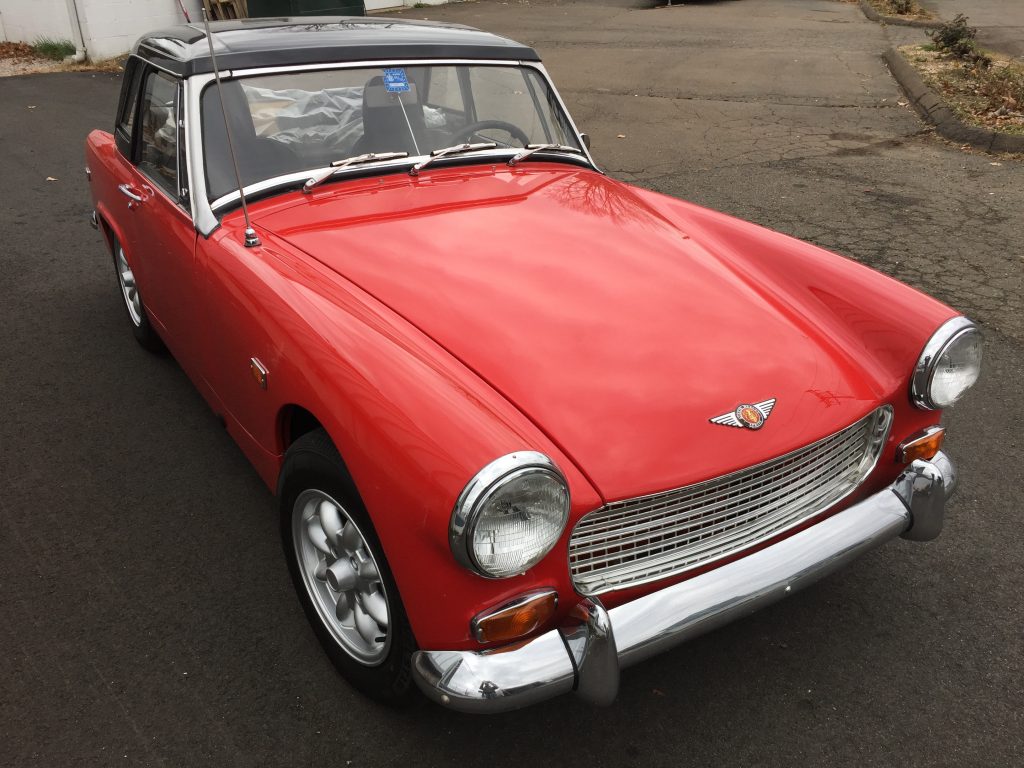
Hardtop and luggage rack are included! Minilights are nice too!
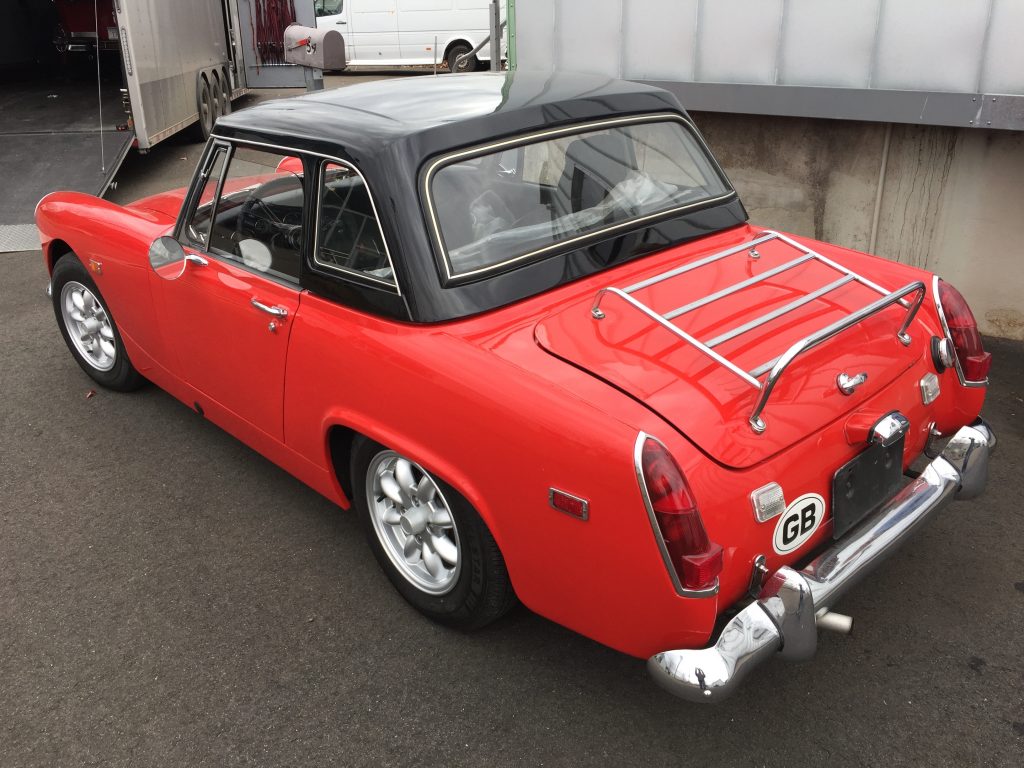
I’ll get the rest of the photos next week, but thought you might like to see something a little different. These are great cars, with roll up windows and all the unibody rigidity and Sprite nimbleness that makes all Spridgets great. Here’s a sweet car if you want to get into the hobby! 1275 power, ribcase transmission, front disk brakes. Call for more details if you would like to make this car your own!
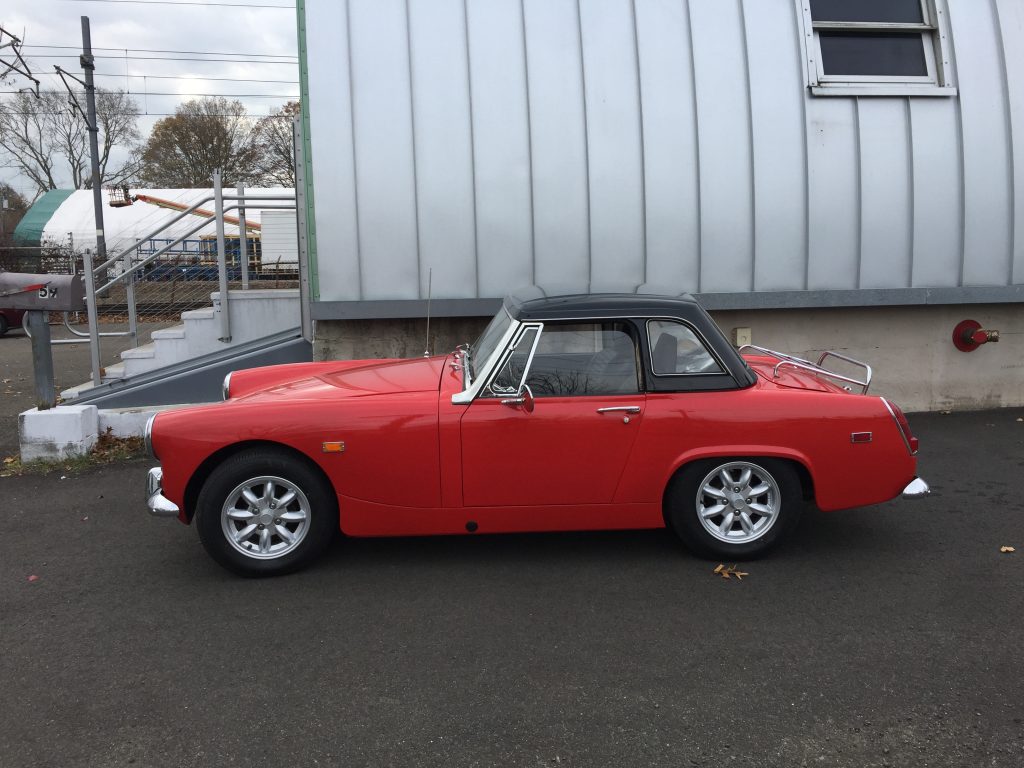
by bugeyeguy
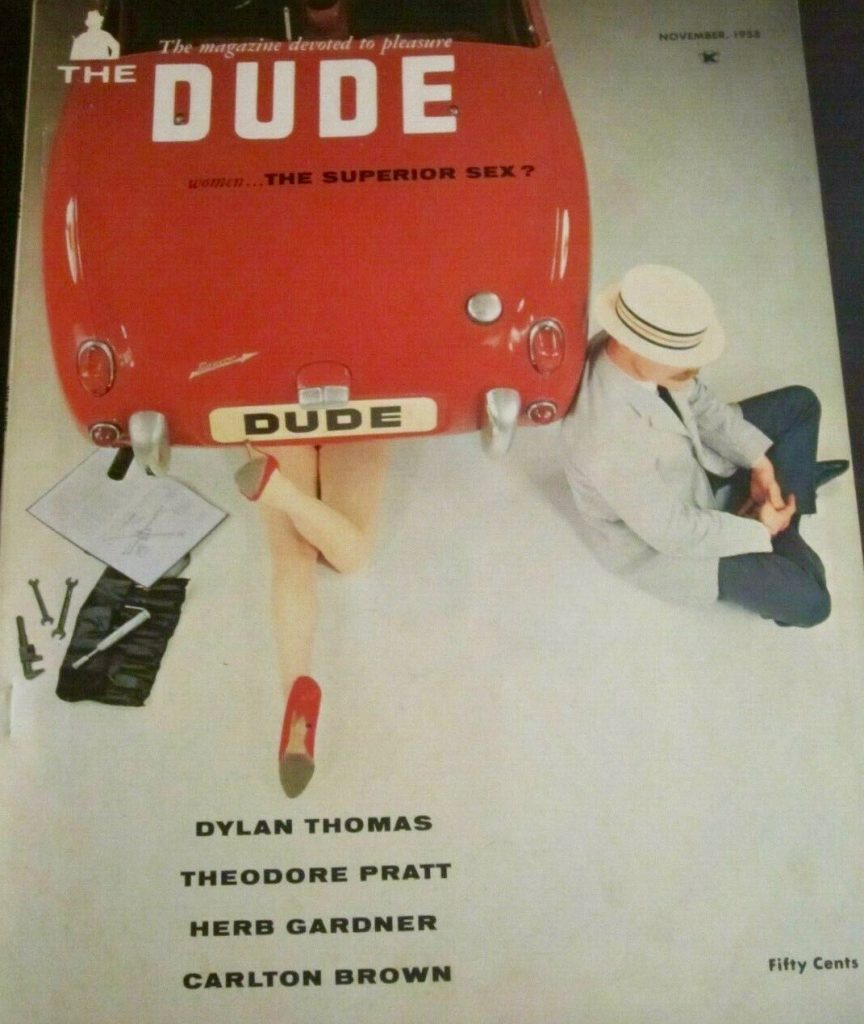

Who’s the dude? In November of 1958, a red Bugeye was the ticket, as long as you had the original tool kit. In 1998, Jeff Bridges took over the title, in “The Big Lebowski.”
by bugeyeguy
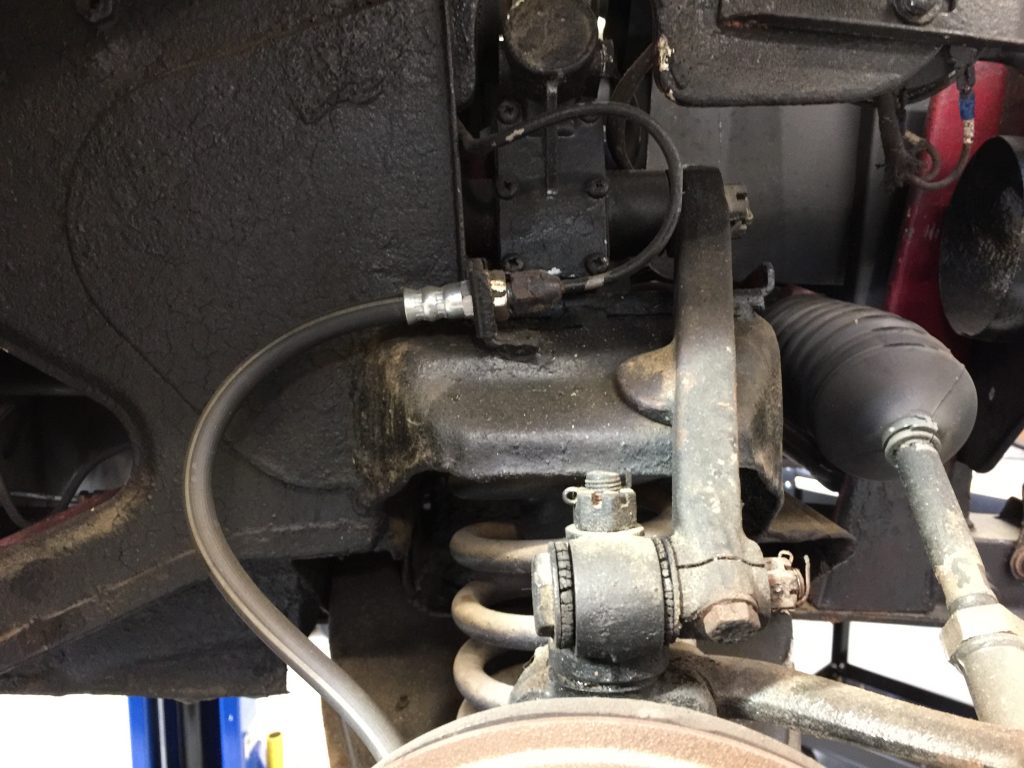
What’s wrong in this picture above? (hint, not the cracked shock bushings). Another clue is below, but see if you can find it before you scroll down…
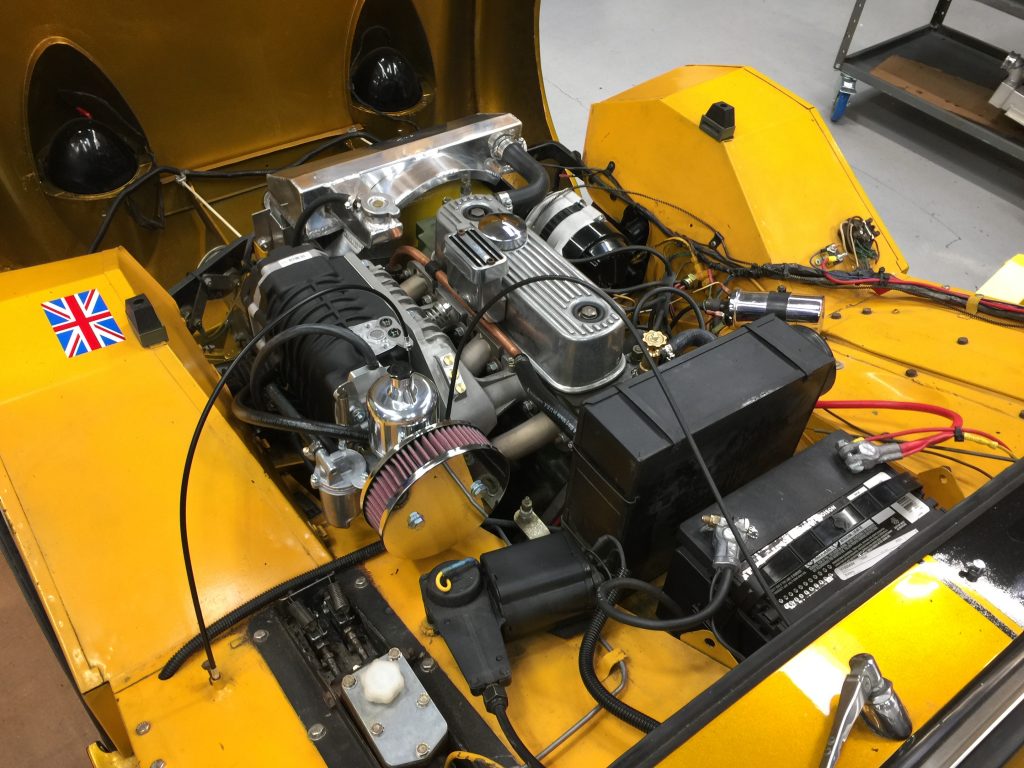
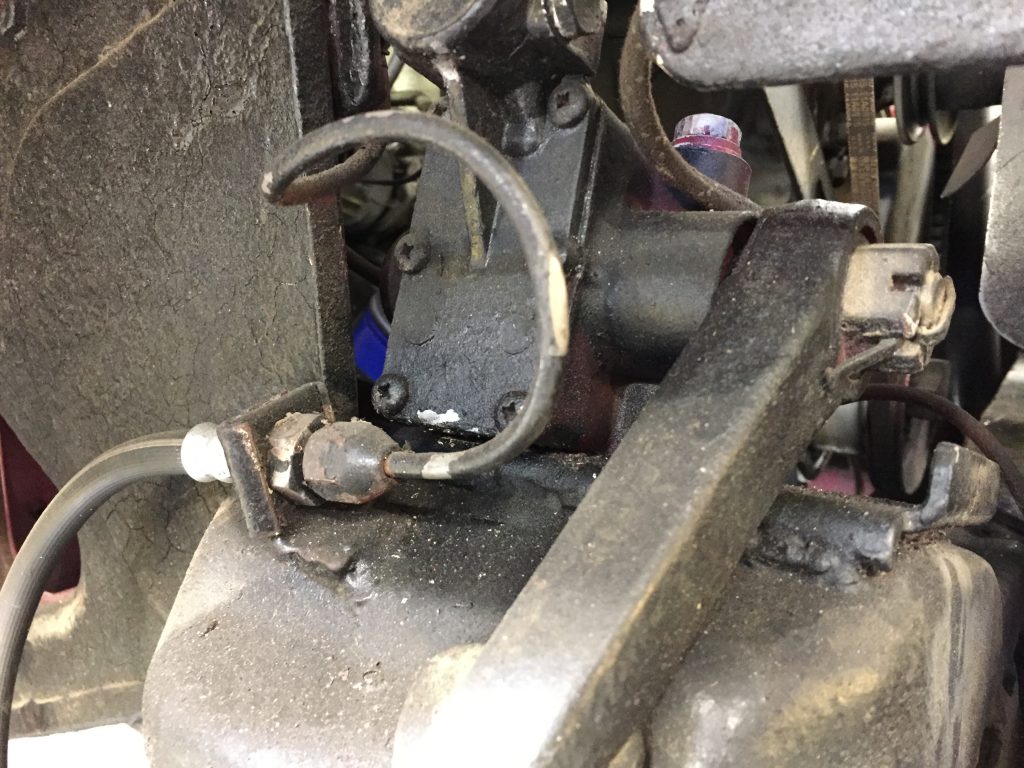
This is a safety concern, and while we have never seen this before, it is worth taking a look at your Sprite to make sure you do not have the same issue. The brake hard line (to the passenger side front brake) was improperly bent or manipulated in such a way that it was contacting the shock arm. As the shock moved through its range, it was sawing into the hard line, which would eventually drain the brake hydraulics and result in a loss of brakes (you can see the silver abraded brake pipe in the picture above, which is where the line would ultimately fail)
This car was sold online by a dealer in California and came to us all the way from the West coast for sorting and repairs. Sending the car all this way has already paid off for the owner, as we just averted what could have been a disaster. We’ll make a new line and install it so it looks more like the picture below.
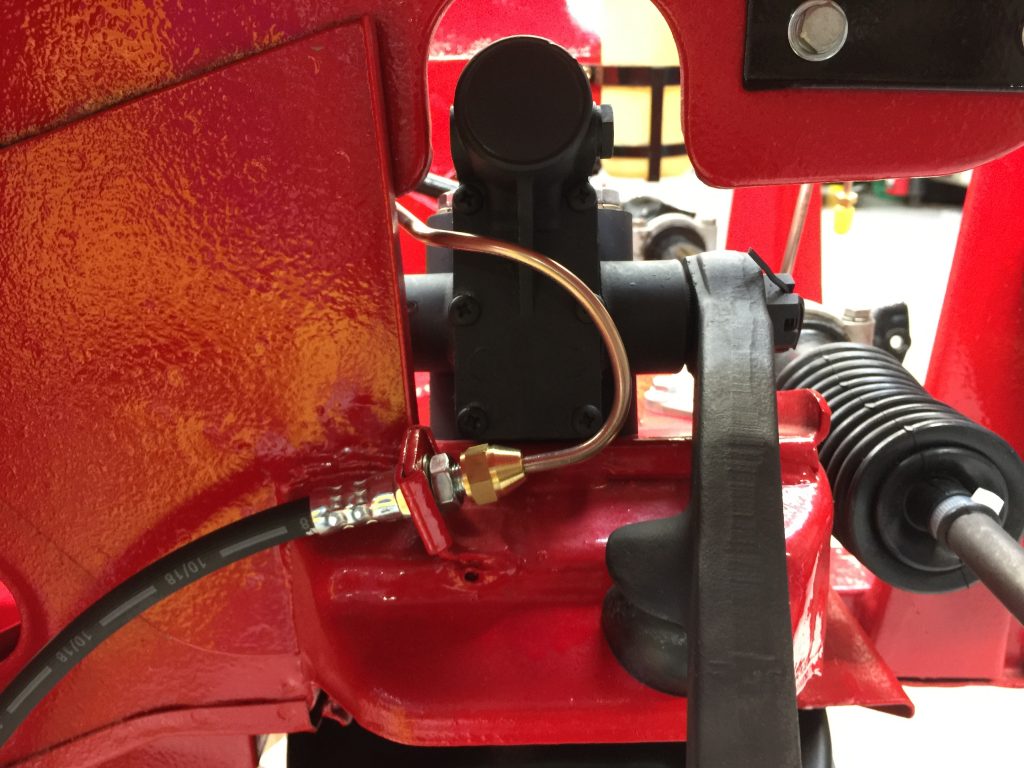
Above you can see a hard line we just installed on a different restored car we are building for a customer from Tennessee. Here you can see the (copper-colored) brake line bent in a radius that keeps it well clear of the soon to be moving shock arm. Make sure you have ample clearance on your car!
by bugeyeguy
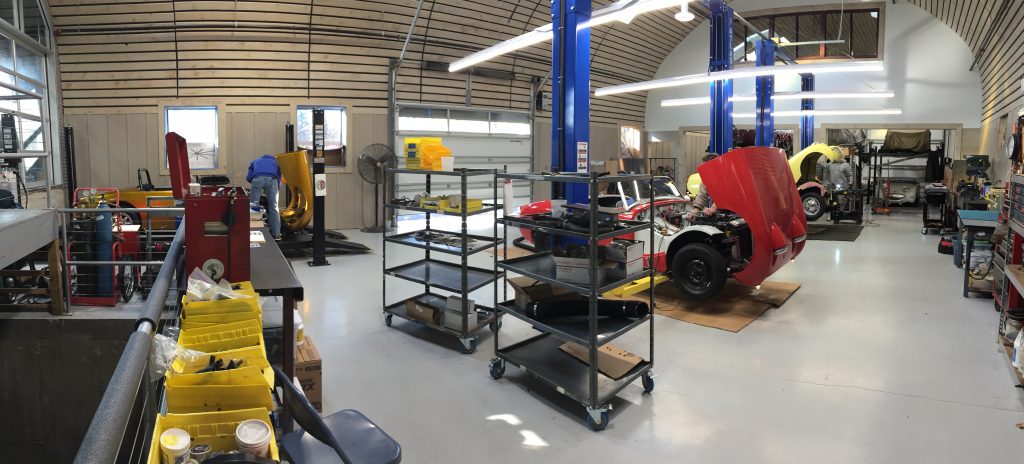
I am filled with gratitude today.
In 2007, I launched Bugeyeguy.com, fueled by passion for a tiny car that I had owned since 1978. Now, twelve years since the birth of our business, here is a photo of our three excellent technicians simultaneously working on three different Bugeyes in the purpose-built addition to our 1951 Quonset hut. That we even own a Quonset hut full of Bugeye parts and cars is remarkable to me, and that we have a new addition (photographed here) is even more remarkable.
All of this was funded by the more than 260 customers who have purchased Sprites from us over the years, and the many more who have chosen us as their restorer and/or parts supplier. For all of you, I am eternally grateful.
By far the most remarkable aspect of this tribute is that in the moment captured in the photograph above, we have simultaneously put to work three different highly talented individuals at three different work stations on the preparation of three different Bugeye Sprites. Once completed, each one is destined for a different state in the Union, courtesy of our network of enclosed transporters.
We have succeeded in creating a national Sprite service center and demonstrated that there is sufficient demand to keep three mechanics busy full time, and for this, I am forever thankful. There are many British car shops in the world, but I doubt you will find another with 20 Bugeyes under one roof and three technicians working almost exclusively on Bugeye Sprites.
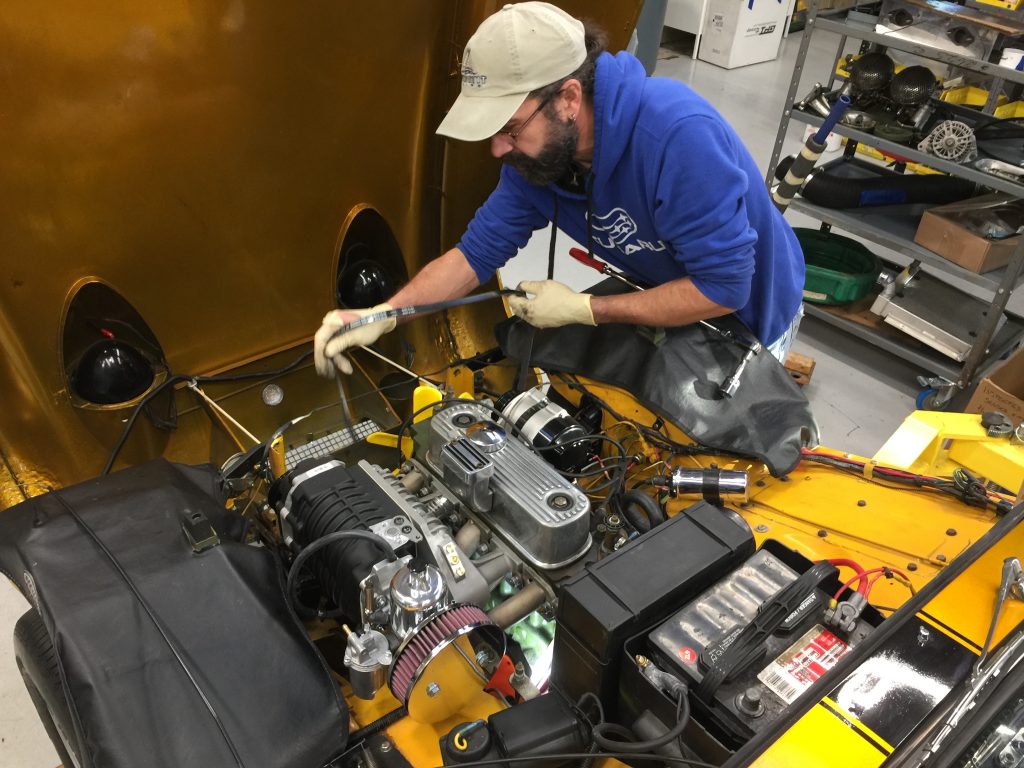
Thank you, dear reader, for your support of our vision, for your support of the entrepreneurial spirit, and for helping us to keep the cars we all love on the road for generations to come.
by bugeyeguy
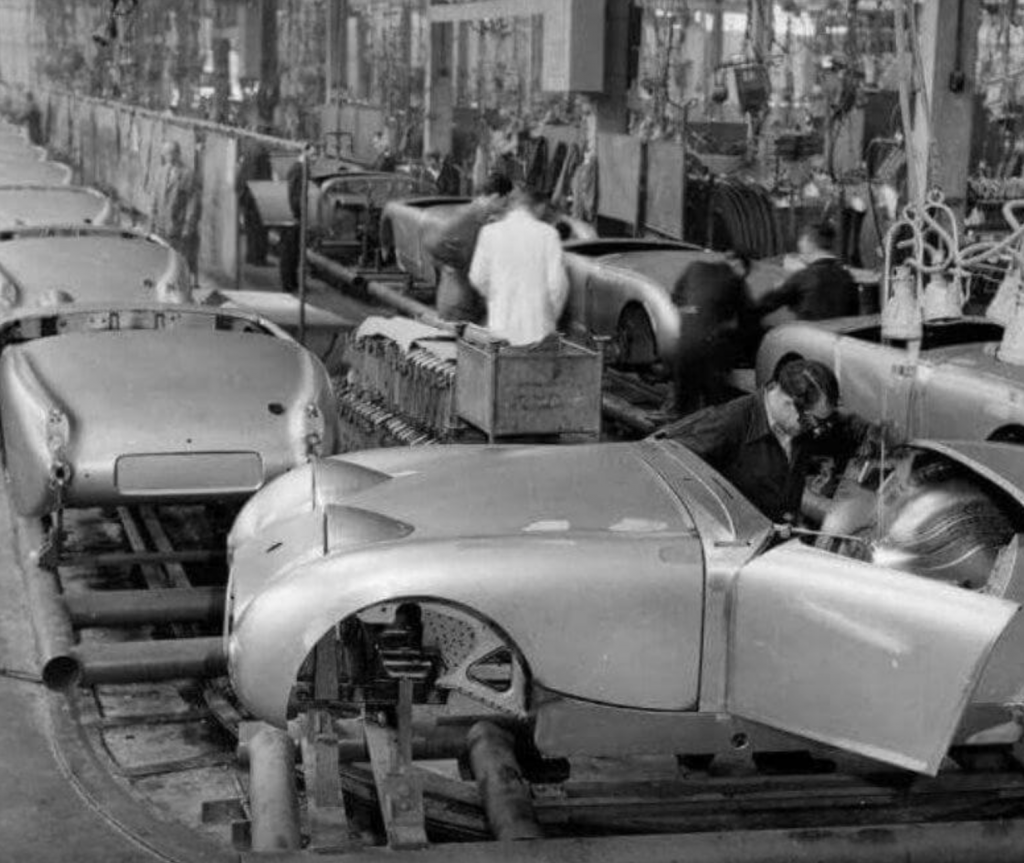
What does “numbers matching” mean to you? In a perfect world, one could be literal, and each car would be mated to an engine with the exact matching digits. In BMC car world, however, nothing matches, and without a heritage certificate, you have no idea if you engine actually came in your car.
Traditionally, we tend to think the matching engine for each Bugeye is “in range,” which has always meant to me plus or minus 500 or so digits. But take a look at the heritage certificate shown below for “Mellow” the 1958 Bugeye, which is soon destined for a new home in Arizona. This car (#6825) has an engine number (#5347), roughly 1500 units out of range.
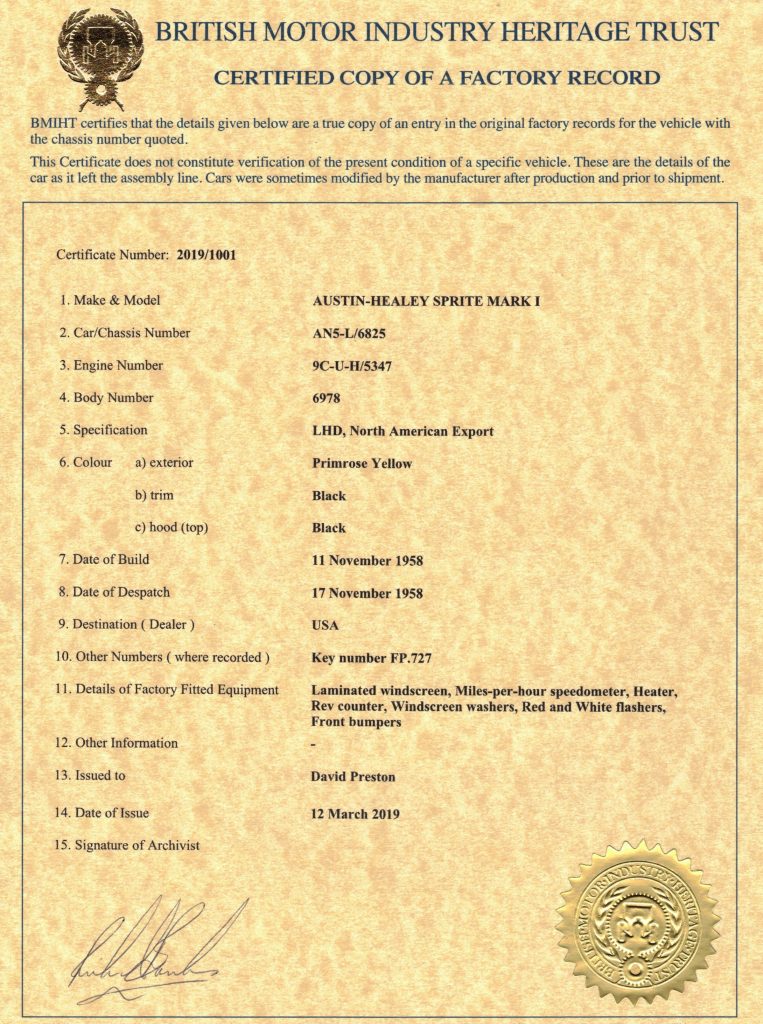
Was this engine rejected, rebuilt and put back into production after 1500 cars passed by? Was this engine hiding under a bench somewhere until someone noticed a perfectly good 948 engine raring to go? We will never know! But at least the heritage certificate confirms that this engine was paired with this car for life (and it is still there to this day).
This particular car was dispatched in mid-November 1958. It would have spent a month or so waiting for a boat ride across the Atlantic, where it would have waited again at a United States dock to clear customs and ship by road to a dealer. The car is titled as a 1959 car, which means the first buyer didn’t come along for the car until 1959, which is not surprising, particularly if the car landed in January at a dealership in a cold climate. I can’t imagine that Bugeyes sold well in the middle of winter.
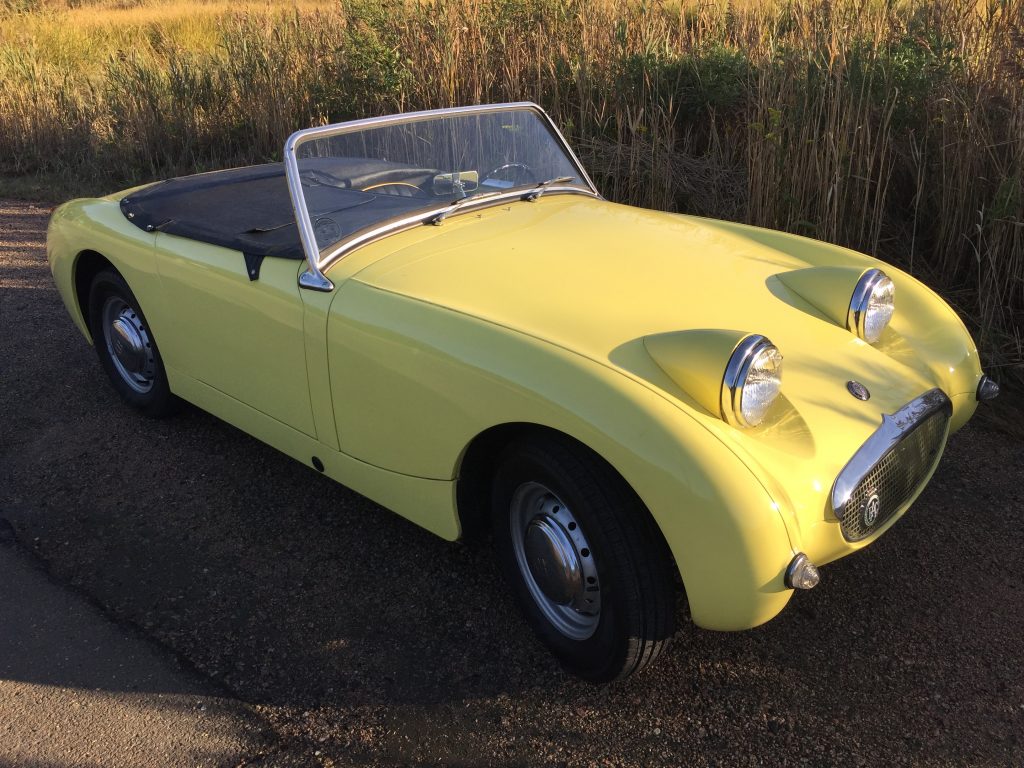
So we have here a completely original car, built in 1958, titled in 1959 and with a matching engine 1500 units out of range. Such is life with the numbering system for most British cars of this vintage. This is not the first (or the last time) we will see this sort of anomaly in the numbering system of the cars we so adore.
If you haven’t got your own heritage certificate, we can help… you can order one here.
by bugeyeguy
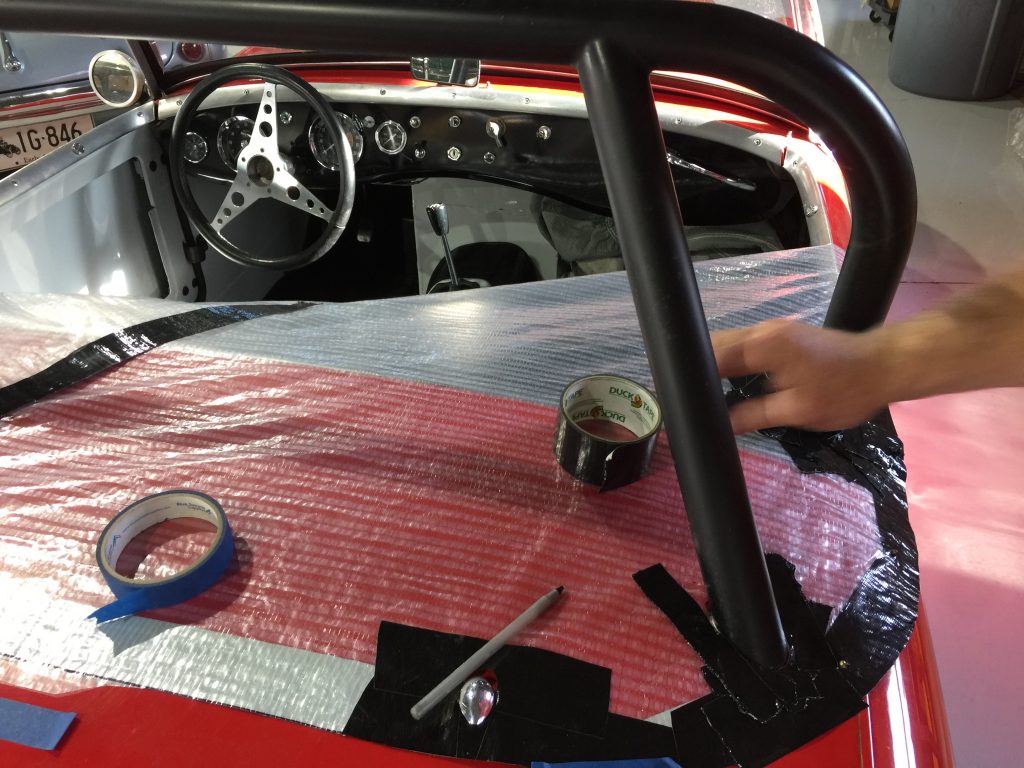
This week, we built a custom tonneau to fit the roll bar-equipped Bugeye above. Kenny carefully templated the roll bar cut-outs (above) and then transferred that template to the deluxe tonneau we sell in our catalog (click if you would like to order one). He made an excellent product, which you can see completed below.
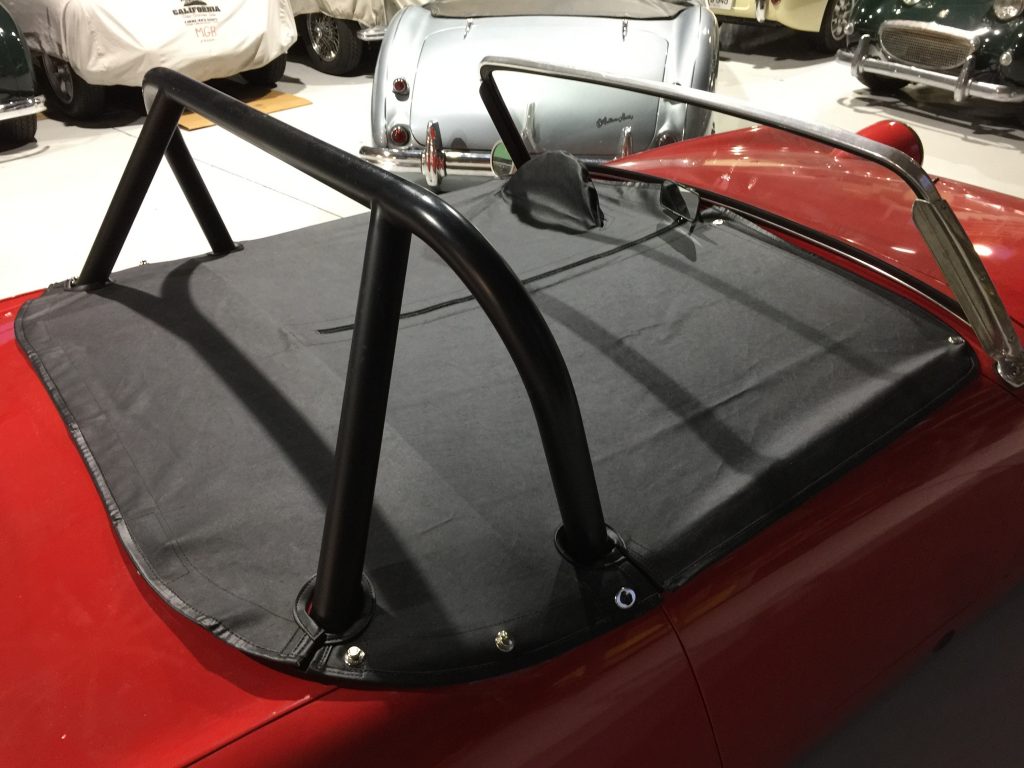
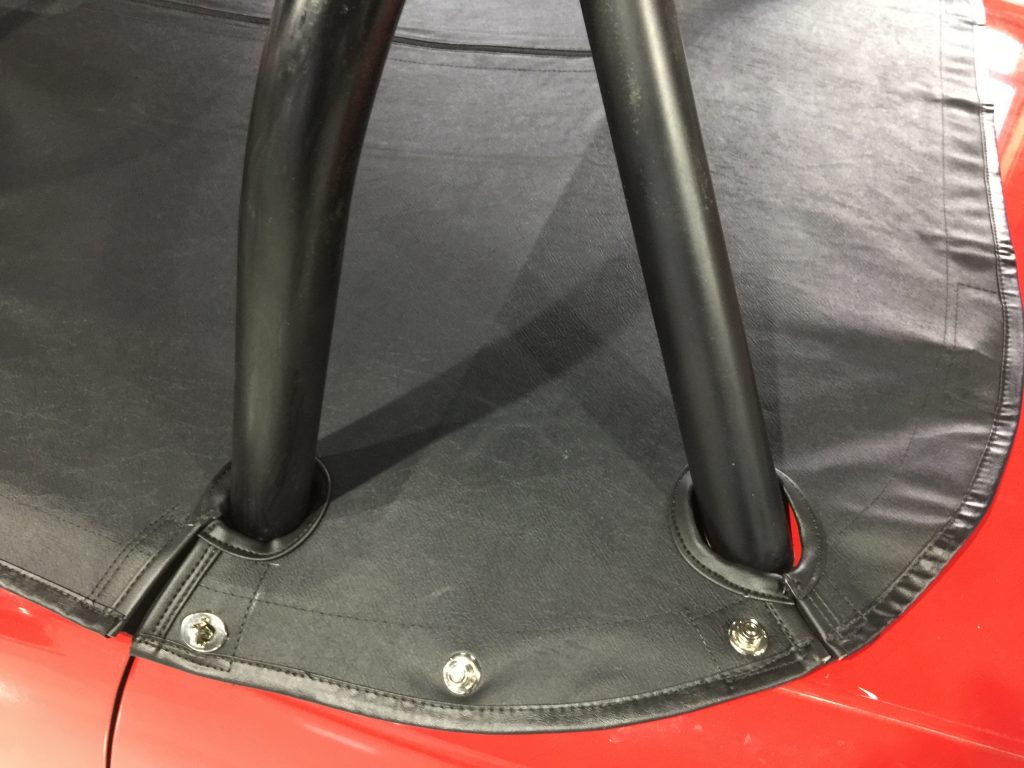
But what about a top? There can be no top bows on this particular car, since the bow holders were shaved when the roll bar was fit. Thus a bikini top makes the most sense, using the roll bar as a hood stick.
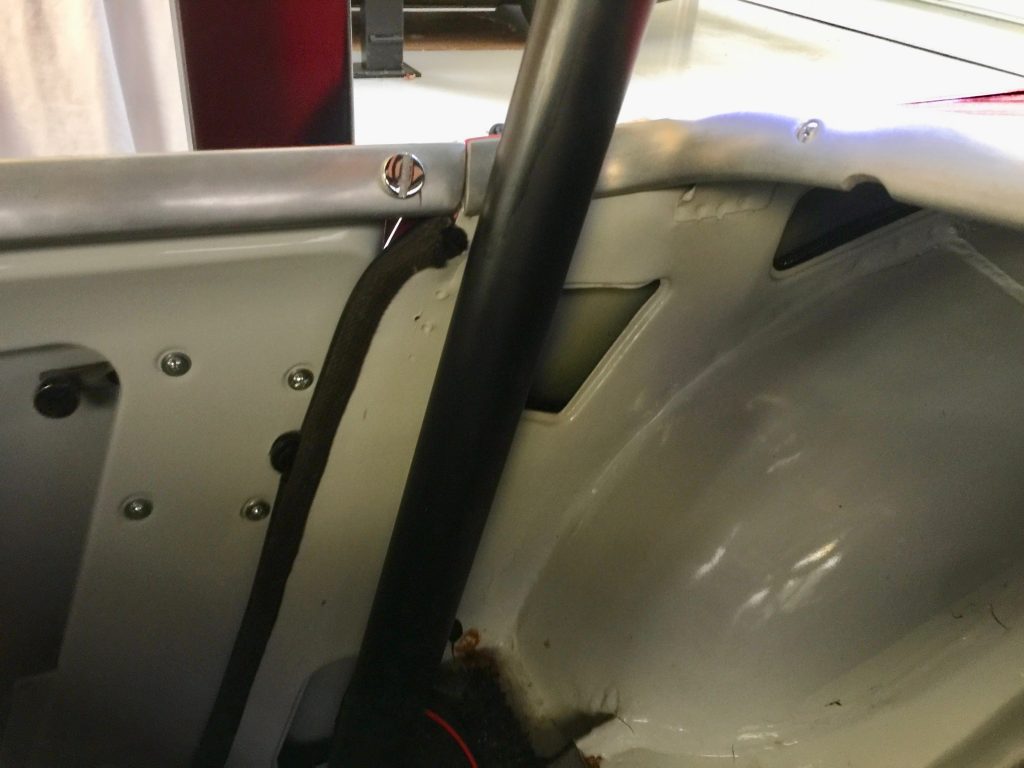
Once more the template paper was used, and once again Ken delivered a superior product. This little pocket racer now has a fitting bikini top, that looks like it has been on there since day one!
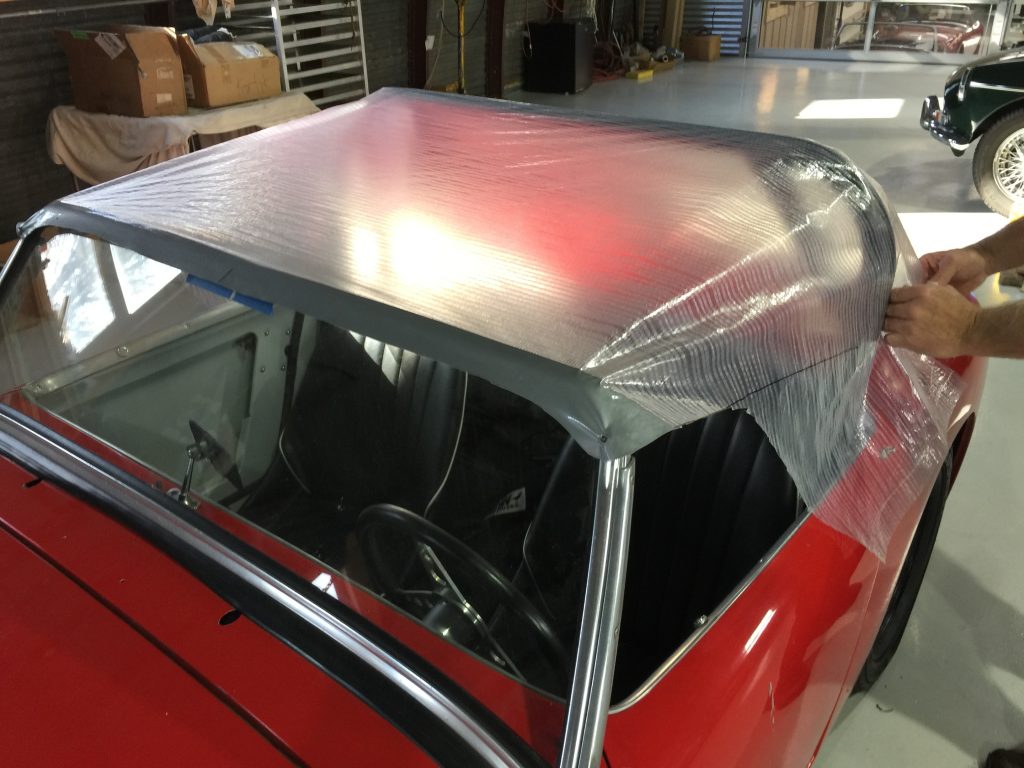
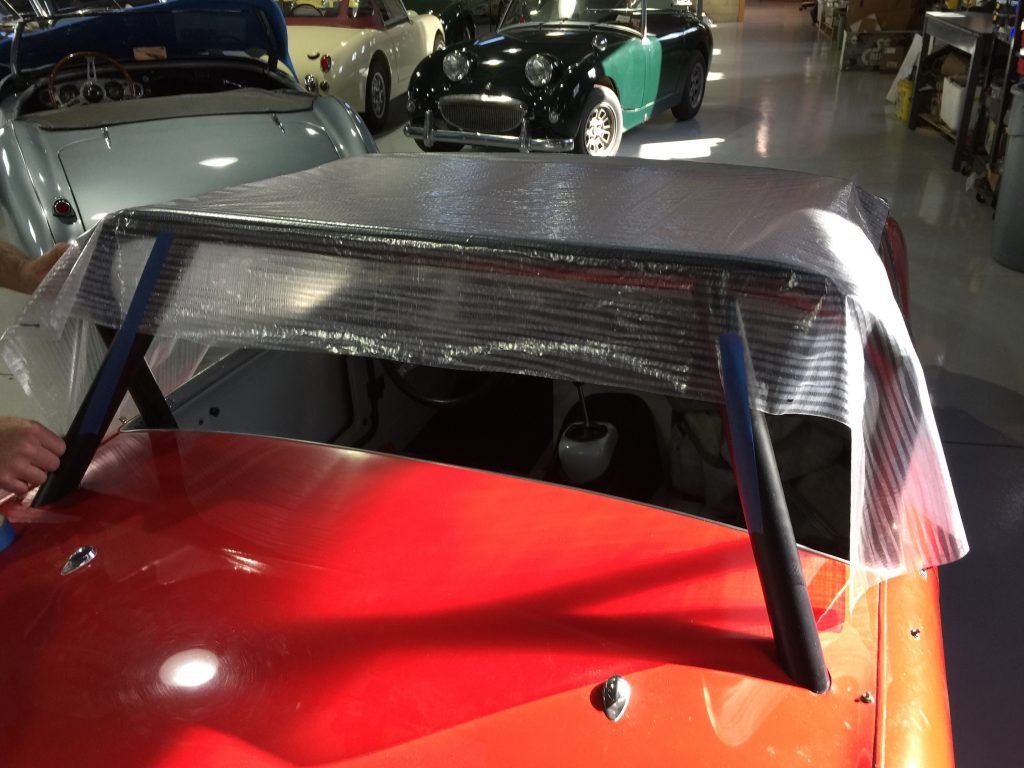
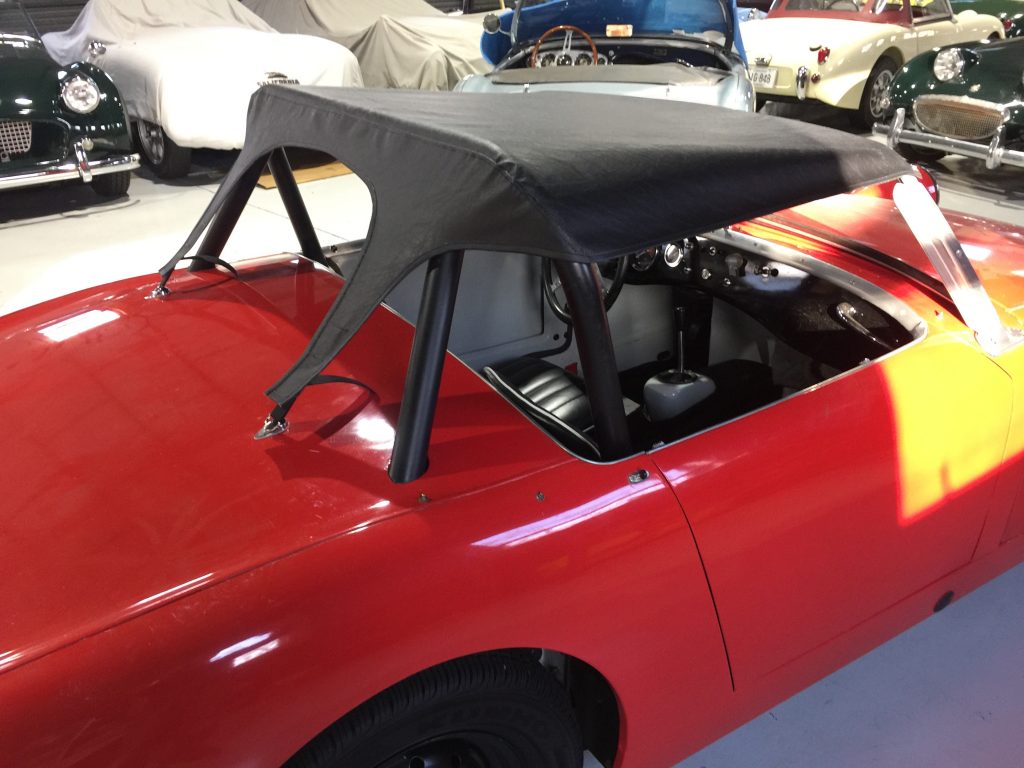
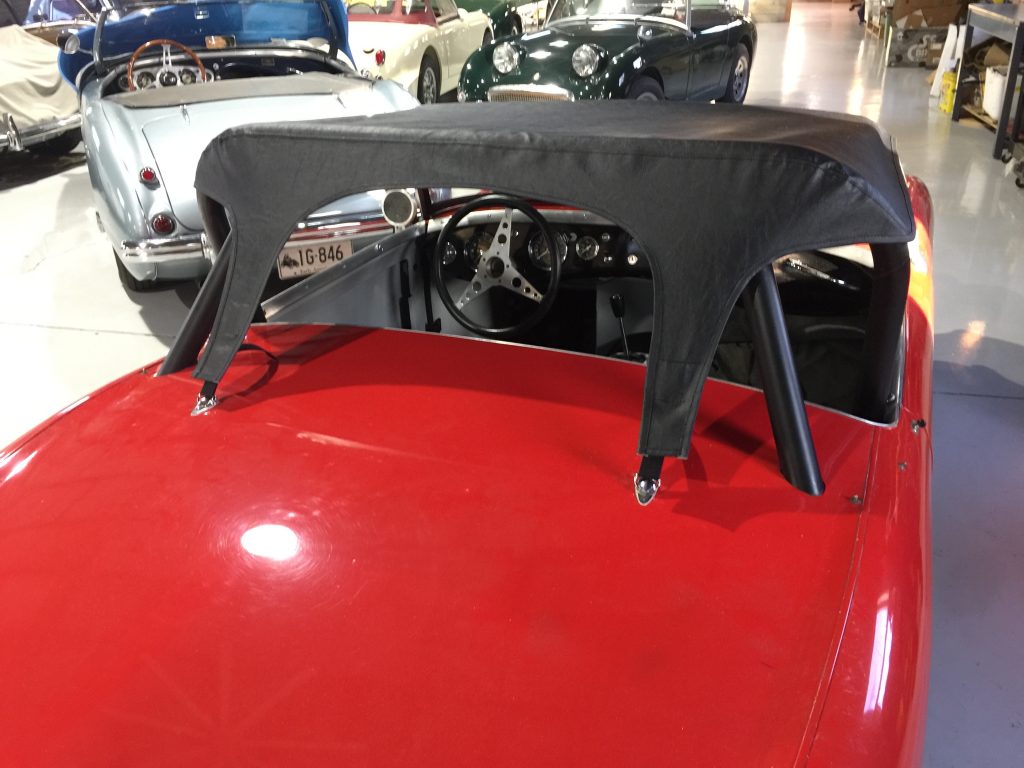
Here’s the finished product (below). The bikini looks quite fitting for this stripped-down little street racer. This car is an online/EBAY purchase from Texas, purchased by an LA resident. We picked up the car in Texas and brought it here to Connecticut for sorting and custom features as shown above. When we are done, we’ll load this “minimalist” Bugeye onto an enclosed trailer for a long trip cross country to its new home in California!
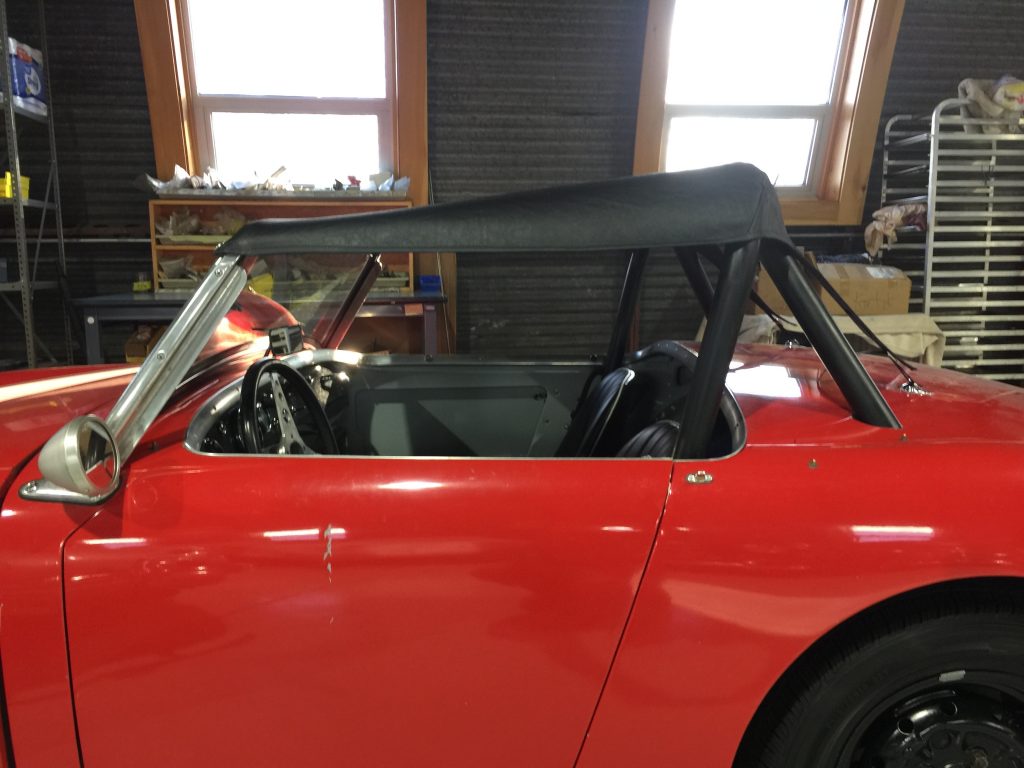
If you want a string bikini top for your own car, you can purchase one by clicking here. We can also make a custom bikini for your roll bar equipped Bugeye, just call or email for more information!
by bugeyeguy
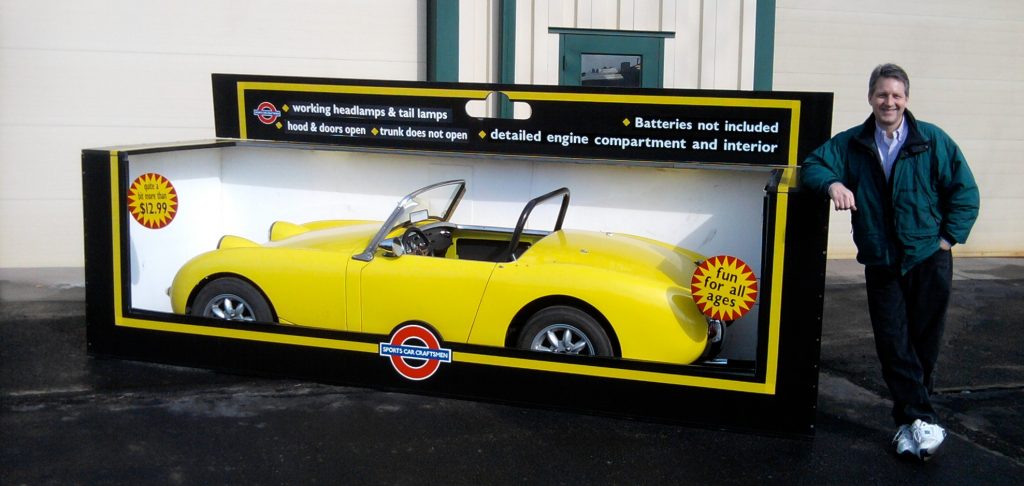
Picture of the week: The guys who made this are ingenious, Sportscar Craftsmen in Colorado.
by bugeyeguy
NOW SOLD to David in Oregon. Congratulations!!!!
NEWS FLASH! This car now has complete weather gear… top, tonneau and awesome side curtains! This great classic just got that much better! With these high caliper and tight side curtains, you can dramatically extend your driving season with this car (she has a heater, too)! This is a great package, don’t miss it!
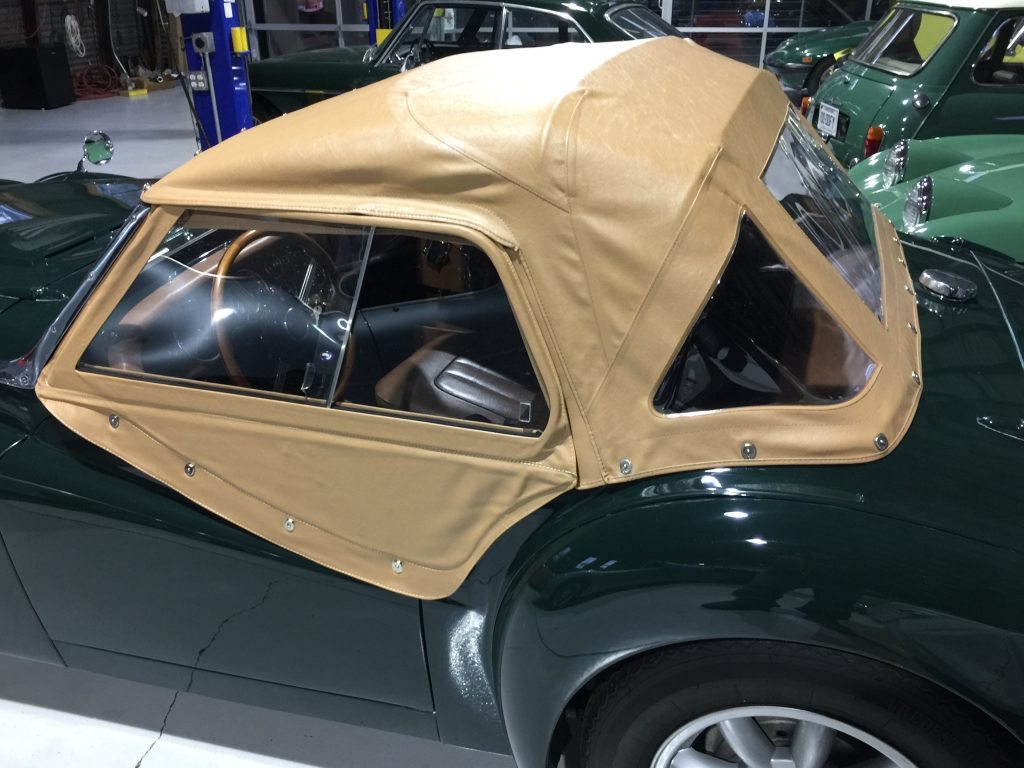
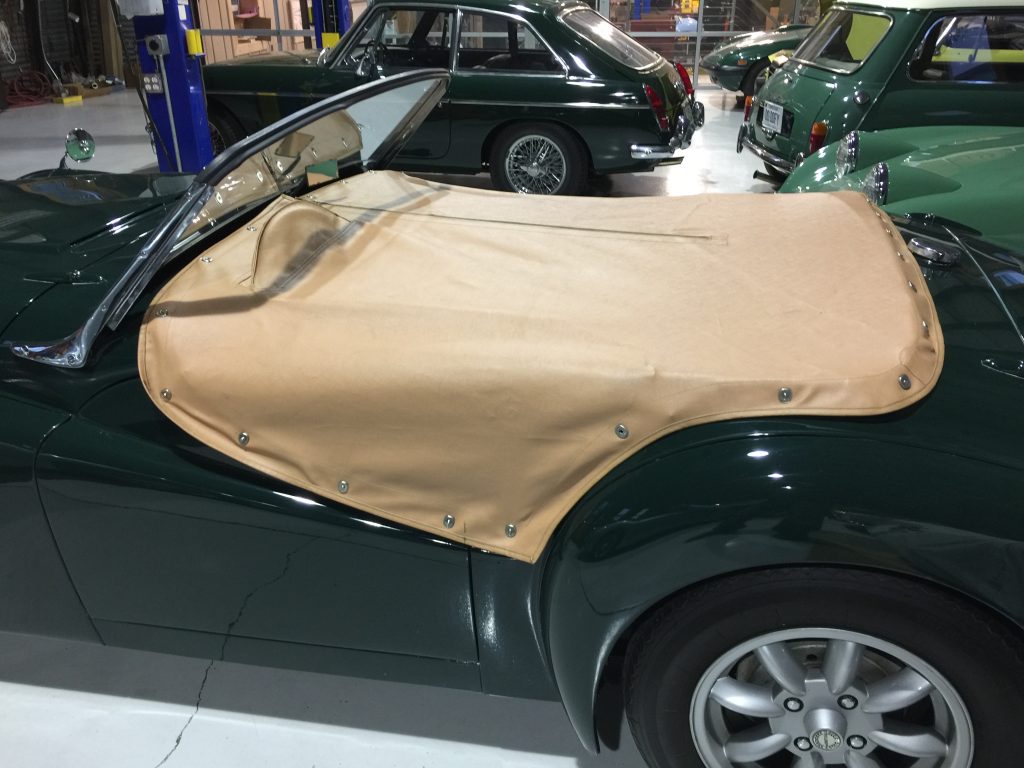
Just 8,636 TR2s were built between 1953 and 1955. This is TS 4431, a rare car, and worth serious consideration.
She was built in 1954 (the last ’54 car was #5191, this one is #4431) and then titled as a 1955, as was common when these cars were purchased and first registered in the following year.
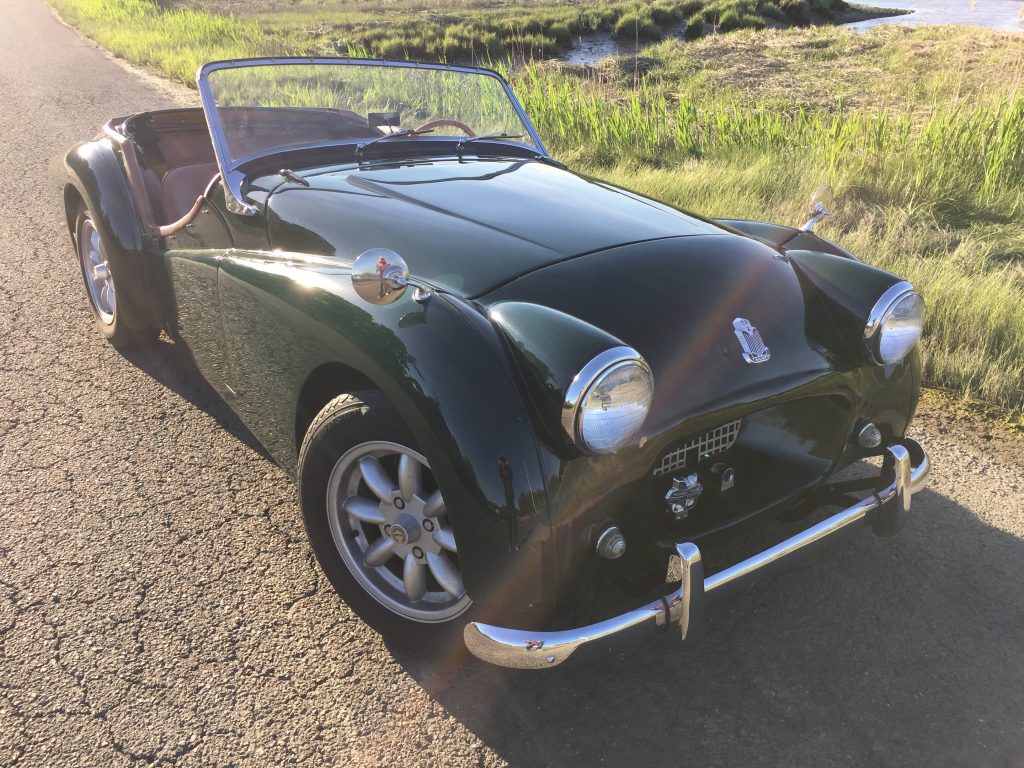
Later in 1955, the TR3 was born, and the grill moved forward, as shown at right below. The white car is a small mouth TR3, of which 17k were built between 1955-1957. In 1958 the large mouth TR3A was born and about 58,000 units were built before the end of the series a few years later.
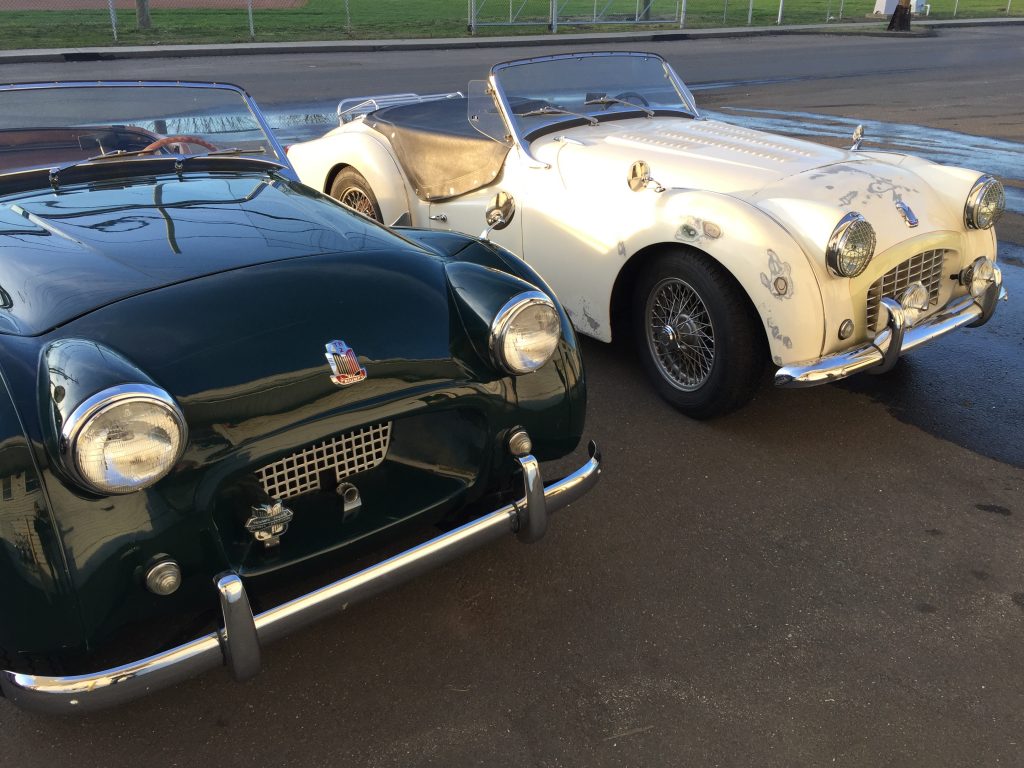
Each variant is wonderful. But the TR2 is visually the most unusual. The grill is brilliant, raw and simplistic, and a perfect fit for this rugged car. I love the small mouth TR3 but the TR2 snout always seemed more appropriate for the car than later versions. And there just don’t seem to be many TR2s left anymore.
Thus I am in love with this short door four speed TR2 because of the subtle differences it has from the more common TR3s. I never tire of the unique small mouth and I love the clean doors with no external door handles. I am sorry they added door handles to the TR3, some purity was lost. And I love the vintage center brake light, unique to TR2s.
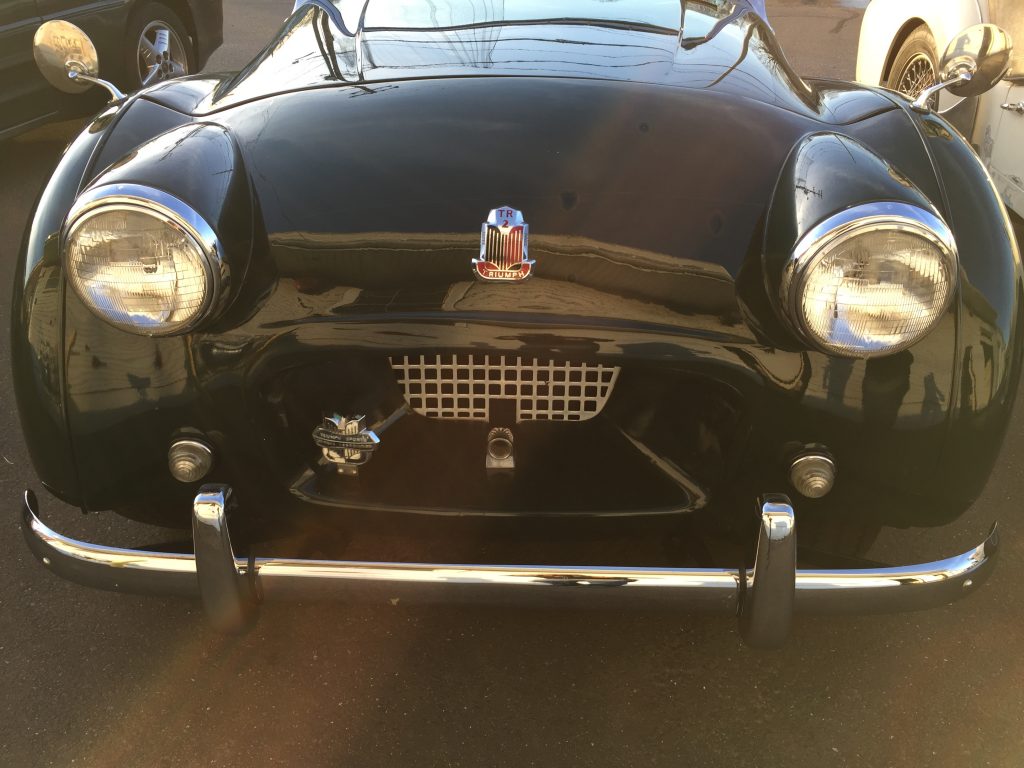
This particular car was formerly vintage-raced. The log book is included and shows a tech inspection in 1988. It was subsequently restored for street use by the long time owner. The car was sent to Marque specialist Macy’s Garage in Ohio in 2011 where they went through the car and did some sorting of the prior restorer’s work. They also upgraded the front brakes to disk. I have asked them to see if they can find the receipts from that service work in 2011.
I bought the car from a (meticulous) collector in Florida who wasn’t using the car any more and wanted to move it to a good home. The car is really fun to drive and it’s tight and quick. It also has tremendous curb appeal.
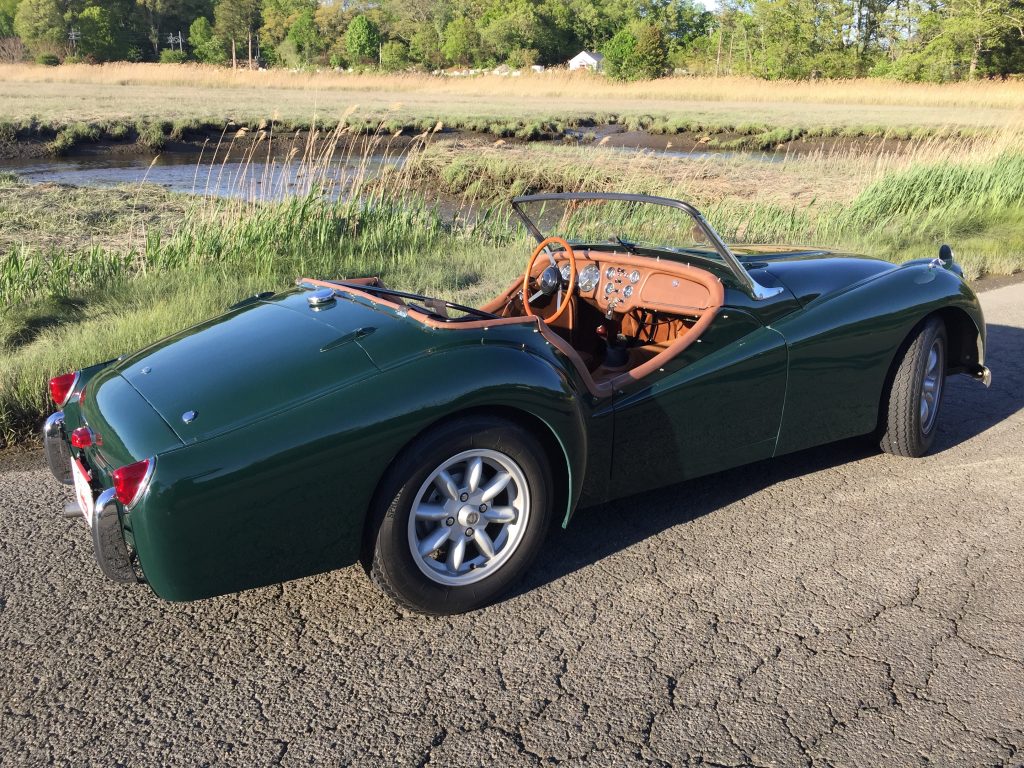
Note the lack of lock fittings on the front of the bonnet-the TR3s had these external chrome fittings to hold the bonnet shut. You’ll see those fittings on the boot lid and spare tire hatch below. You need the T handle key to open them… but no outside latch fittings on the bonnet. Early cars had an internal (and more practical) hood release.
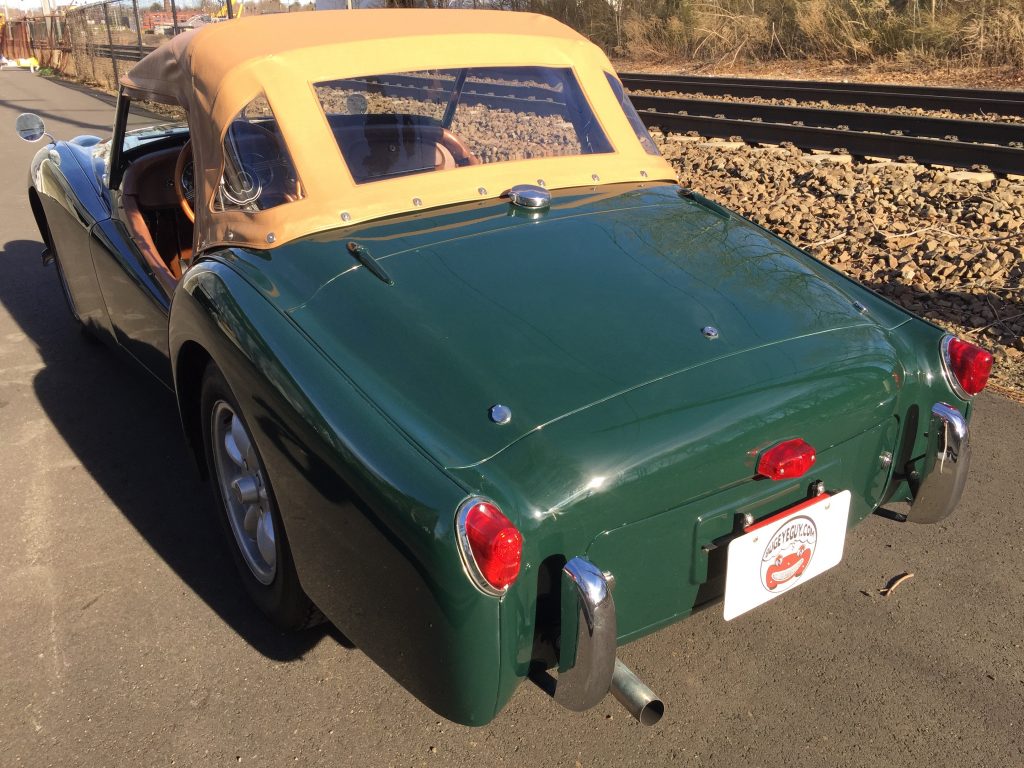
The top is nearly new, as is the interior. The side curtains too are a nice bonus, and in great shape. You can see them in the boot, with nice clear plastic windows. The interior was also completely redone, and also looks nearly new.
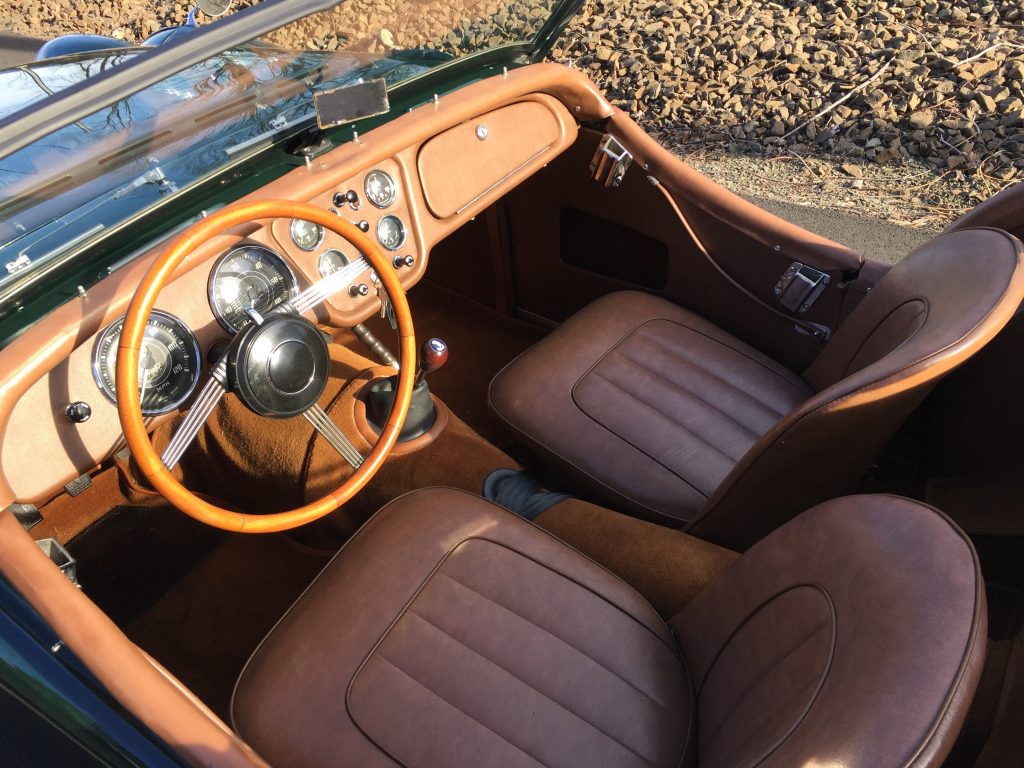
A trickle charger is hard-wired in place under the bonnet in front of the battery. There’s a battery kill switch in the passenger foot well. This is a nice anti-theft feature. A spin-on oil filter is also present, for easier oil changes.
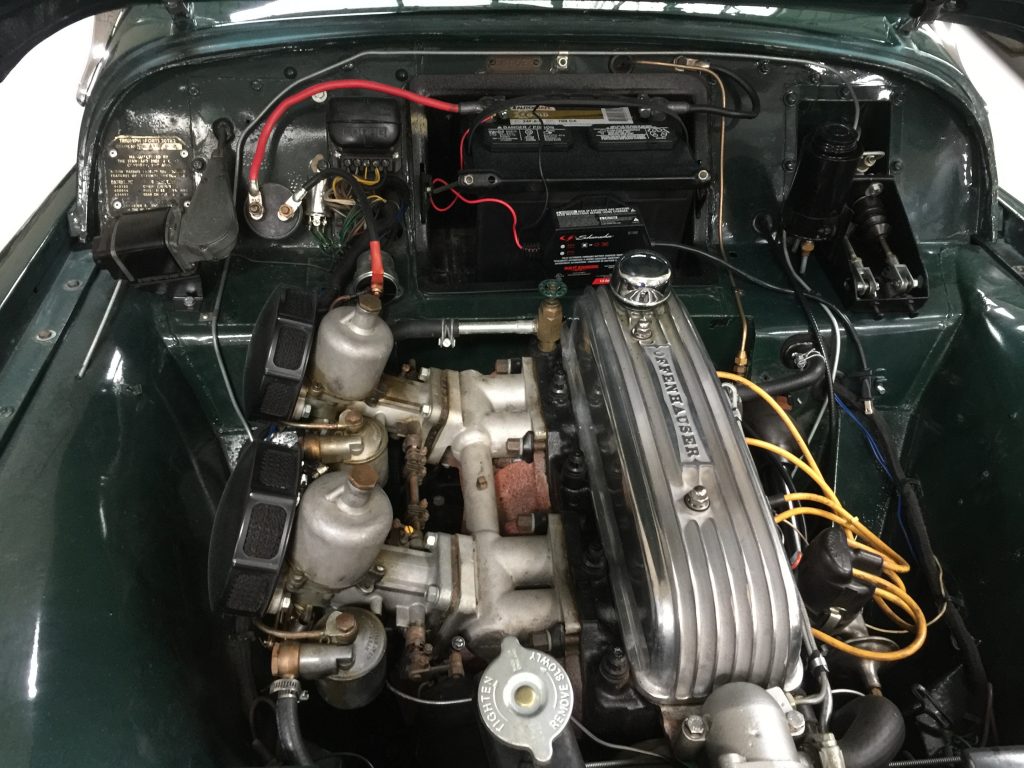
The car spent a lot of time in California, as confirmed by early registrations which are shown in the photo gallery. At some point the car moved to Ohio, and then on to Florida. The car is quite solid, the underside looks quite nice.
Give a call if you want to discuss this rare and wonderful vintage car!
by bugeyeguy
Which is superior, a Frogeye or a Bugeye? This has long been debated without resolution. Dozens of comments on our Youtube channel claim that one is superior to the other, and that one (or the other) is the most correct and genuine of the breed.
BTW, did you ever notice that all Sprite steering wheels are canted, as though to make more room when you get in or out of the car?
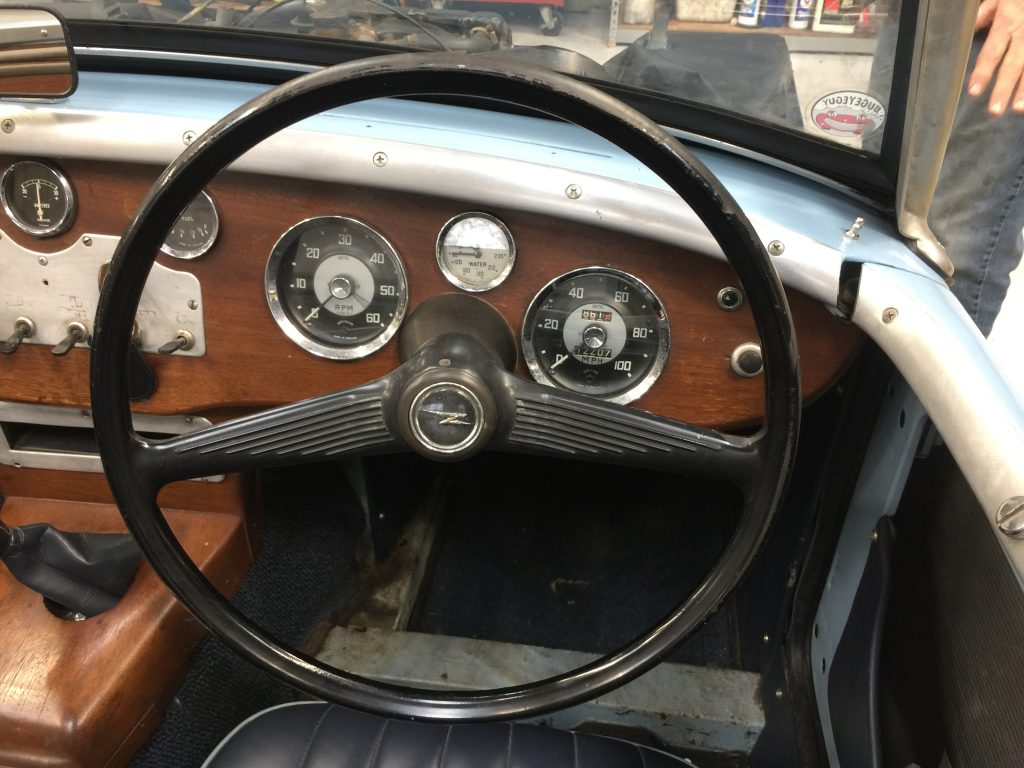
Brits cry “Frogeye!”
Yanks cry “Bugeye!”
Can’t we all just get along? (Times like these, we gotta stick together!).
Frogeyes are home market right hand drive cars, while Bugeyes are left hand drive cars sent to America and other markets.
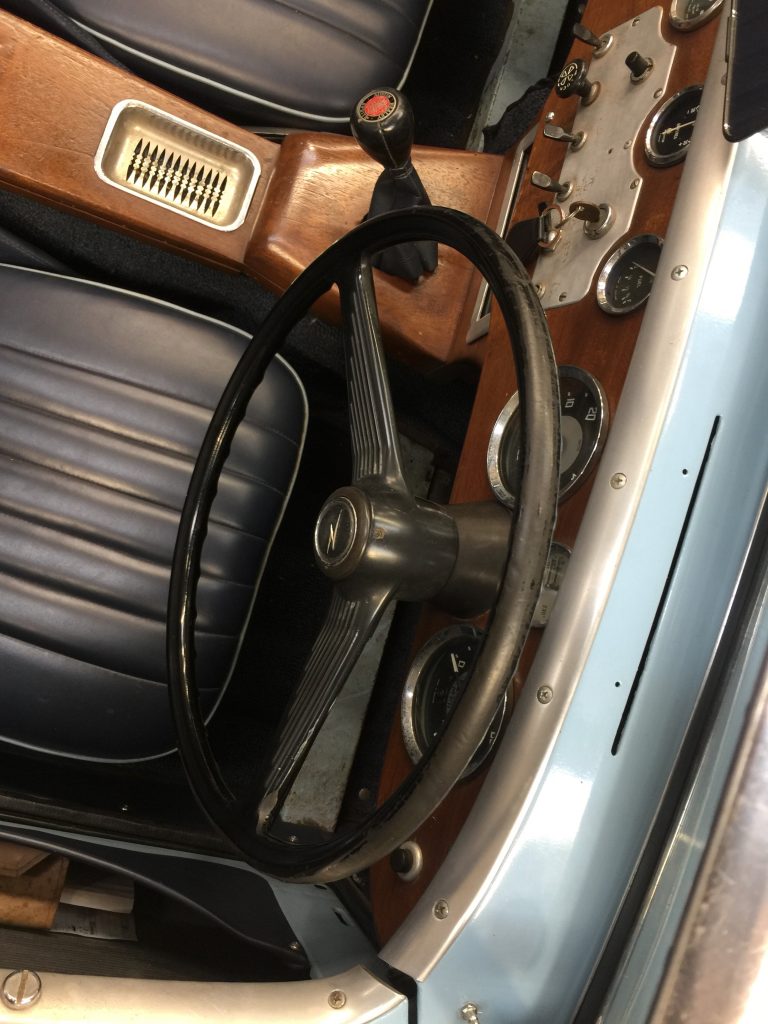
Before anyone claims superiority, I noticed something this week that is a tangible difference between the two species; Right hand drive cars have a more angled steering wheel than left hand drive cars. I believe this is because of the oil filter assembly, which nearly hits the steering shaft on a RHD car. If the steering wheel was parallel to the dash, the steering column would hit the filter. On a LHD car, there is a little more room because there is little in the way.
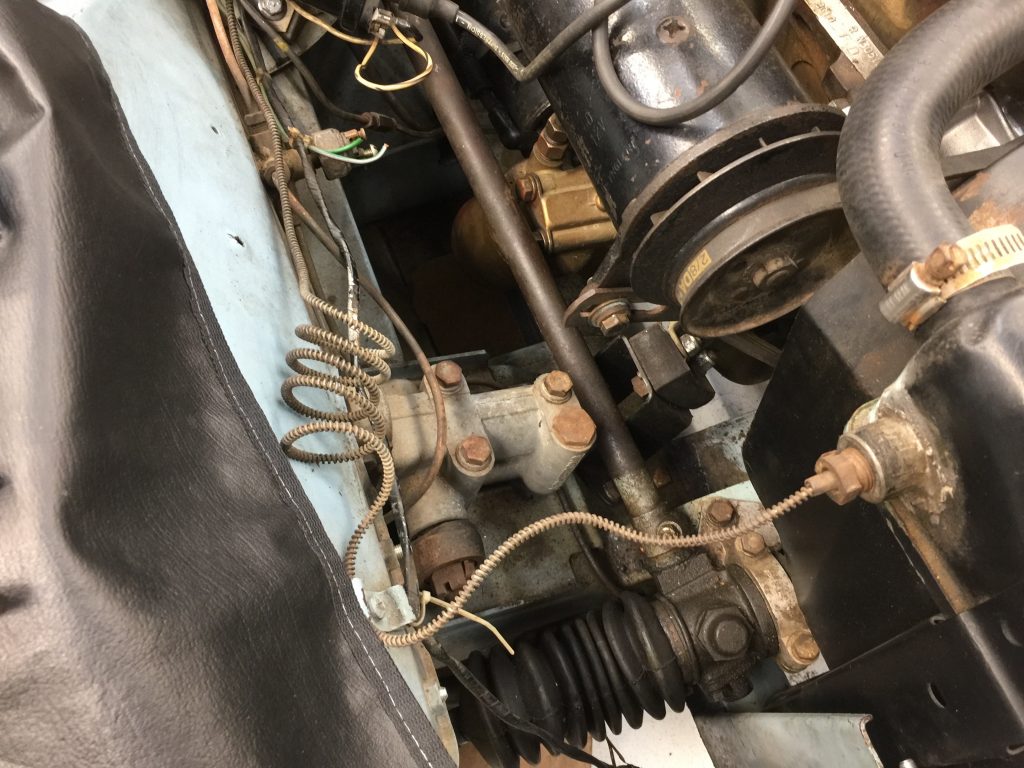
Alas, the difference… the steering wheel on a right hand drive car is further angled than on a left hand drive car
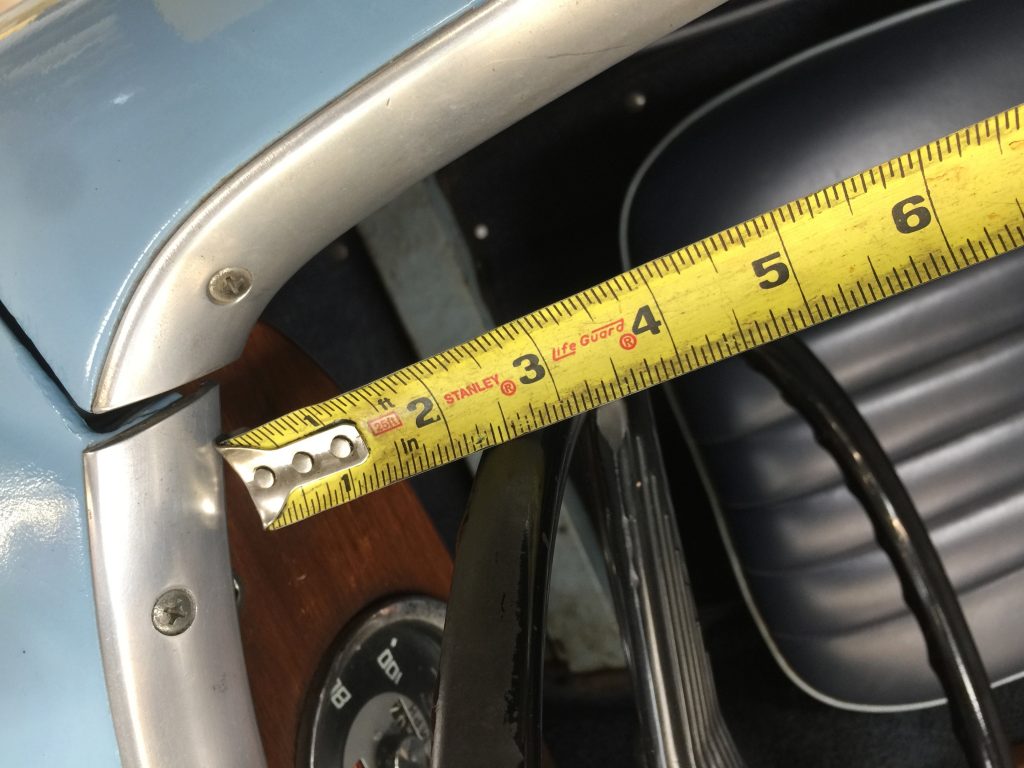
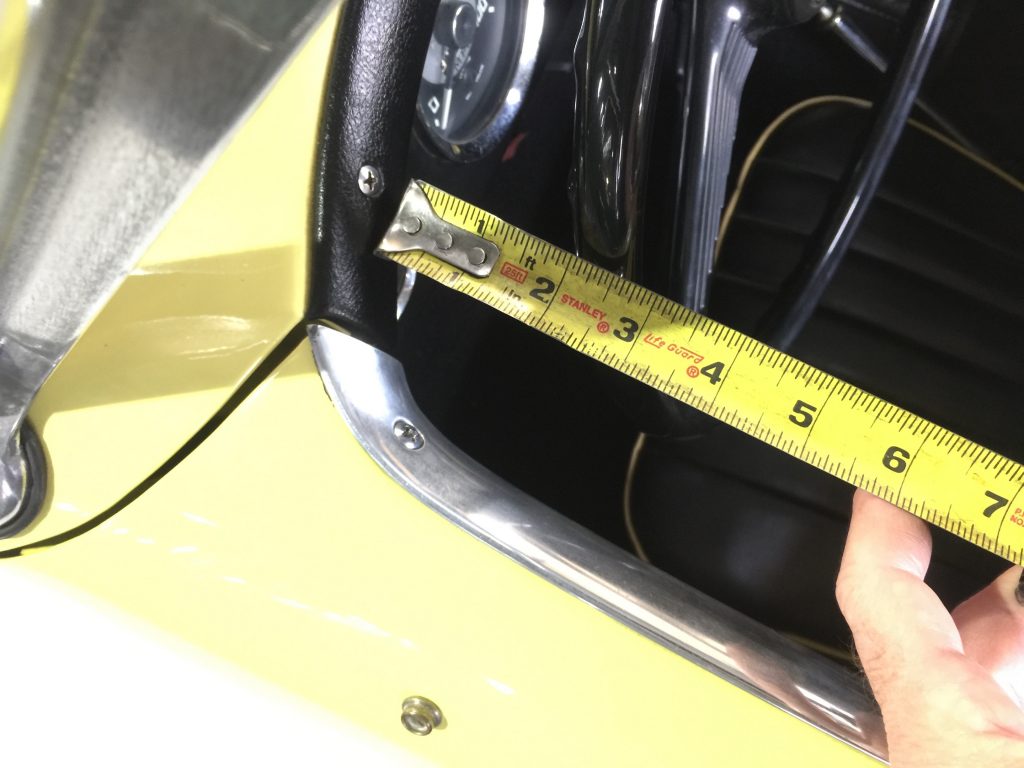
Now we all get back to arguing which is a better name for the cars we all love so dearly.

